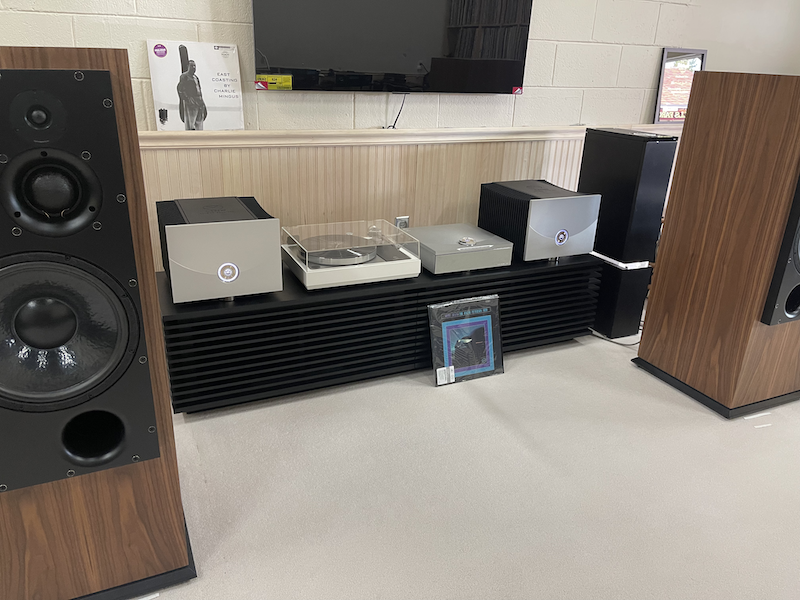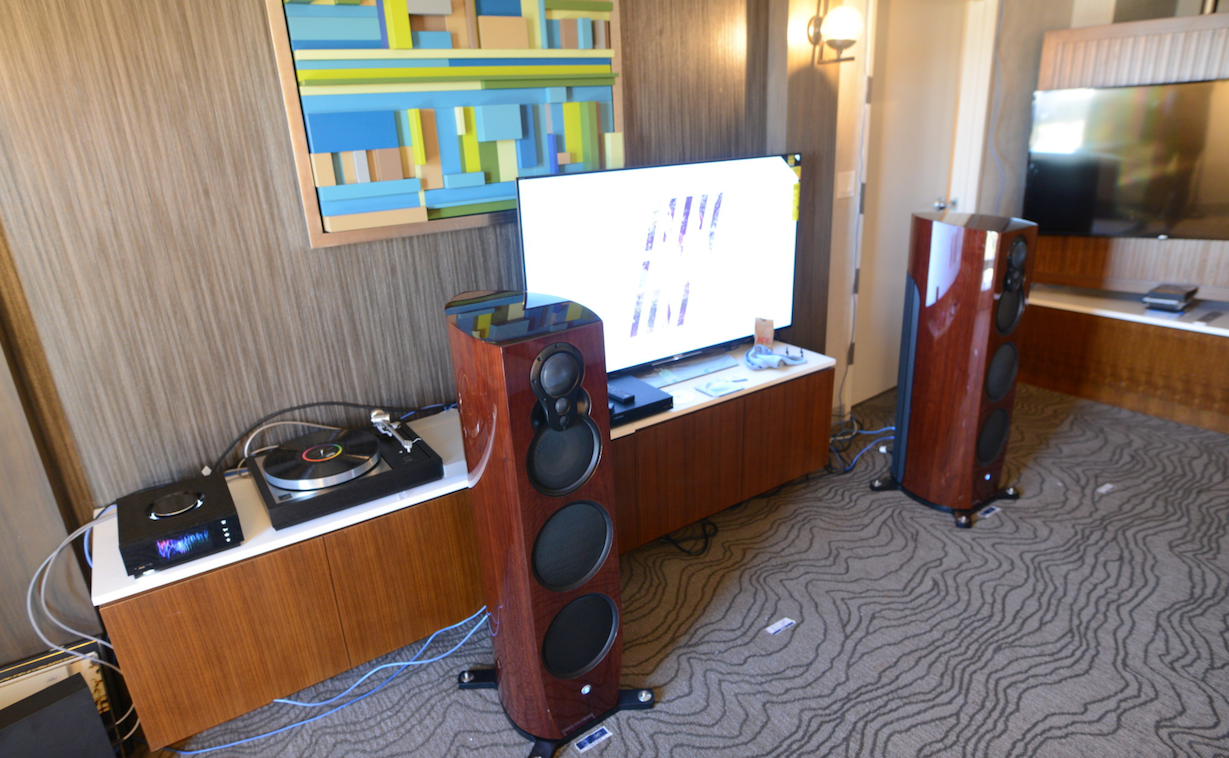
Stereo-
variants or stereo-
: solid : solid body
b
: having or dealing with three dimensions of space
stereochemistry
(courtesy of Merriam Webster)
Recently Basil Audio held a series of listening sessions at our San Francisco Bay Area store in Saratoga, California. Attendees were invited to listen to a system that we had built to evaluate and demonstrate the new Linn Klimax Solo 800 mono power amplifier. While the rest of this system has provided us with a reference for some time, the Linn amplifiers were new and provide the option of a system architecture departure from the reference active Linn speaker systems, and so we felt that this system represented a good way to assess the amplifiers alone with otherwise familiar electronics and speakers.
At Basil Audio, while we strive to present the best sounding music systems and components to customers at every price point, our goal is to install, assess and adjust the complete system so that it reveals music – not just sound, not just the squeaking of John Bonham’s kick drum pedal, not just dogs barking outside the recording studio. We want to hear every note, in tune and on time. Unfortunately slight errors in speaker placement, miss-guided but well-intentioned cabling tweaks that add phase distortion and unaccounted for room distortion and many other factors detract from us achieving this goal. To deliver a complete system we need to rely on the truthfulness of our manufacturers and our own ability to asses the final result before we present to customers.
As a result, Basil Audio has come to learn so many “this was better than that” lessons we cannot possibly cover them all in a single review. Some of these surprise people and provoke strong reactions when they come up in conversations in our store. For example, when powering passive speakers we’ve often preferred a single stereo amplifier to two mono amplifiers. The advantages of mono amplifiers in a stereo system are obvious at first sight. Each channel can be supplied with the maximum current of 15 or 20A from the 110-120V mains supply in the US, whereas a single stereo amplifier would share this maximum current with both channels. On the face of it there should be better separation between amplifiers having separate power supplies, cables, chassis and so on. In some cases those responsible for installing the system may prefer to position each amplifier closer to its respective speaker, shortening the speaker cable length in the process. However for some time we’ve found that the seperation of left and right amplifiers tends to distance us from the music somehow, the sound of each channel is clear enough, the sought after “center image” is clear enough however some of the “solid” feeling, the “three-dimensional” feeling and possibly even tune and timing can suffer if we don’t take extra care with the setup.
Why we have this feeling that mono-blocks are not always to be preferred over stereo power amplifiers we don’t completely understand. However one clue could be the practical differences between the amplifier channels themselves. We know that some manufacturers go to great lengths to select and even match components in their amplifiers. Many unanswered questions remain. How closely matched are they actually? Would two amplifiers that are close in serial numbers be better matched? How about consecutive serial numbers? What about if one amplifier is near a drafty open door and the other is close to a corner of the room? If the amplifiers are plugged into different wall outlets does one wall outlet “sound” different from another wall outlet? Which of these and other factors are important and which aren’t? Potentially the new Linn Solo 800 has the answer to these questions.
Intelligent Power Amp
According to Linn, the Linn Solo 800 amplifier features a technology called Adaptive Bias Control. This system automatically adjusts the bias current for each of the amplifier’s transistors in real-time.
Traditionally, Class AB amplifiers, like the Solo 800, require a specific bias current to minimize distortion. However, this current can drift over time due to temperature changes and use. Linn’s Adaptive Bias Control addresses this issue by constantly measuring the current supplied to each transistor and adjusting it to the optimal level.
This continual adjustment offers several benefits:
- Reduced crossover distortion: By keeping the bias current ideal, the Solo 800 minimizes distortion that can occur when the signal transitions between positive and negative voltages.
- Consistent performance: The automatic adjustment ensures the amp performs at its best regardless of volume level, music dynamics, or operating temperature.
- Long-term stability: Throughout the lifespan of the amplifier, Adaptive Bias Control helps maintain optimal performance by automatically counteracting any bias current drift.
Linn call the power supply in the Linn Solo 800 “Utopik“. The Utopik power supply is a novel switch-mode design that delivers both high performance and efficiency. The key features of this high-tech approach that concern us here are:
- High Power Output: It provides a maximum of 2kW of power, making it suitable for demanding loudspeaker systems.
- Clean Power Delivery: The Utopik employs multiple feedback loops and intelligent Valley Switching to minimize electrical noise and ensure a pure, stable output voltage even with fluctuating mains input or dramatic changes in speaker load.
- Efficiency: Utopik utilizes a technique called soft-switching to minimize energy loss such as through heat and improve overall efficiency. This also contributes to quiet operation.
- Precision-Regulated Power Rails: The power supply maintains consistent voltage levels across its rails, ensuring optimal performance for connected audio circuits.
We decided after trying several speakers to use the ATC SCM100. This speaker is famously easy to drive, presenting a nominal 8 ohms load even at low frequencies. Therefore the voltage part of power amplification will be very well tested. This is also important since we know that it’s possible for an amplifier to be good at driving current without being able to control voltage equally well in which case load dependent anomalies would be apparent. The ATCs can also play at high sound pressure levels without distortion such as you might hear in a live performance, so we looked forward to that part of the evaluation as doing so requires sufficient current – the ATCs would reveal any limitations at those higher sound pressure levels.
At about the same time as receiving the new Linn amps, we took delivery of our 2-channel demo pair of ATC C4 Mk2 sub-woofers. We had already installed these sub-woofers in several home theater applications where we drove them with the single LFE (low frequency effects) channel, however this would be the first system we had set up with two C4 Mk2 subs in a stereo configuration, that is one for left and one for right. The full evaluation of these sub woofers is a subject for another planned review. Apart from the overall system performance elevation that we found during our initial listening tests, we felt it would be important to add the sub-woofers to make use of the convenient balanced output XLR provided on the rear panel of the Linn Solo 800s. This is relevant because it fits into ATC’s recommendation to leave the main speakers with their natural, non-resonant low frequency roll-off and place the sub-woofer roll-on at a somewhat low frequency (in our case 50Hz) to retain an overall response free of frequency peaks and limit any phase distortion. Note that this also places demand on the amplifier and is a very good test – we see that some amplifier manufacturers recommend passing the full bandwidth signal from the preamplifier or source firstly to the sub-woofer, then from the sub-woofer to the main amps, thereby rolling off the main amps when used with sub-woofers to reduce the load on the amps at low frequencies and improve mid and upper bass control. We are deliberately doing the opposite as provided for by Linn with no need for “Y-cables” or additional first order “stability filters” that can only increase phase distortion which would be the enemy of successful sub-woofer driver and dedicated amplifier integration between the main speakers and Solo 800s.
How does it sound?
The very first track we listened to was the Infernal Dance of the King from Stravinsky: Firebird Suite (1919 Version), a live Bavarian Radio Symphony Orchestra recording with Mariss Janson, released in 2019 on BR-Klassik – 24 bit/48kHz FLAC. No system gets a second chance to make a first impression and what a first impression. We were unprepared for the attack of the very first note. Or we should say, the lack of attack. The sound made by the first massive, complex and dramatic tutti and fff chord actually starts before you register the timpani mallet has struck and a fast release reveals the response of the concert hall long after, during the rests in the remainder of the first bar, sounding as only live music possibly can – even the harpist is playing their very own eight note chord, four of them accidentals. Can anyone hear every individual note in the chord? We believe not. Based on this one chord, we could end the review here, as it really tells us everything we need to know about this system and the ability to exactly capture such a huge musical event.
Next up: The Gap Band, Yearning For Your Love from their 1980 album on Mercury Records 16 bit/44.1kHz. This band is an everlasting reminder of Black Wall Street in Tulsa, Oklahoma, spelling as it does the three main streets Greenwood, Archer and Pine of that neighborhood where the Wilson brothers forming the band are from. The signature hooks at the start of the track and incredibly catchy tunes and bass grooves the band is famous for, give way to beautiful harmonies and guitar solos that are simply enthralling. All of this is depicted as a four minute masterpiece by the pair of Linn Solo 800s. How many times have we heard this track as background music in grocery stores, on the radio or streaming without being able to wonder at the the whole song and all of its parts.
Another favorite live recording of ours is Haydn: Symphony No. 100 “Military”, Handel and Haydn Society & Harry Christophers released in 2020 by CORO. This recording is so much fun however one thing that immediately struck us that hadn’t before was the sound of the cymbals in this recording. This is especially true of the finale. One of our customers who happens to be a drummer has a set of Zildjian cymbals set up in his basement so we recognized the sound right away as will anyone who has attended live rock concerts. It turns out that this choice is part of an imaginative take on HIP (historically informed performance). It was Avedis Zildjian in 1623, predating this symphony that discovered the secret process that links to modern day or in this case the antique cymbals actually used. The cymbals along with the bass drum, triangle and the extraordinary Turkish Crescent “jingling Johnny” together have the very last word of the finale, as if a mirror of the impression made by that first chord in the Firebird, with the unmistakeable sound of the cymbals clearly both joined into and sustaining past the last “note”. Played at the right level and with this extraordinary level of musicians’ ability can recorded music sound just like a live performance? Yes.
Conclusion
We can say with certainty that with this system and particularly with the Linn Solo 800s we have found stereochemistry, and at Basil Audio, achieved a truly reference level of musical performance far beyond our expectations using for the first time mono bloc amps with passive speakers and sub-woofers.
System components:
Linn Klimax DSM Network Music Player with Utopik power supply
Linn 50th Anniversary LP12 designed in collaboration with LoveFrom
Linn Majik DSM (used as a MM phone stage and network source for the Majik LP12)
Linn Solo 800 Amplifiers
Naim Statement Preamplifier
ATC SCM100PSLT Loudspeakers
ATC C4 Mk2 Sub-woofers
Cables: Basil Audio and Naim Super Lumina
Space optimization (Linn’s room correction system) performed by Basil Audio


